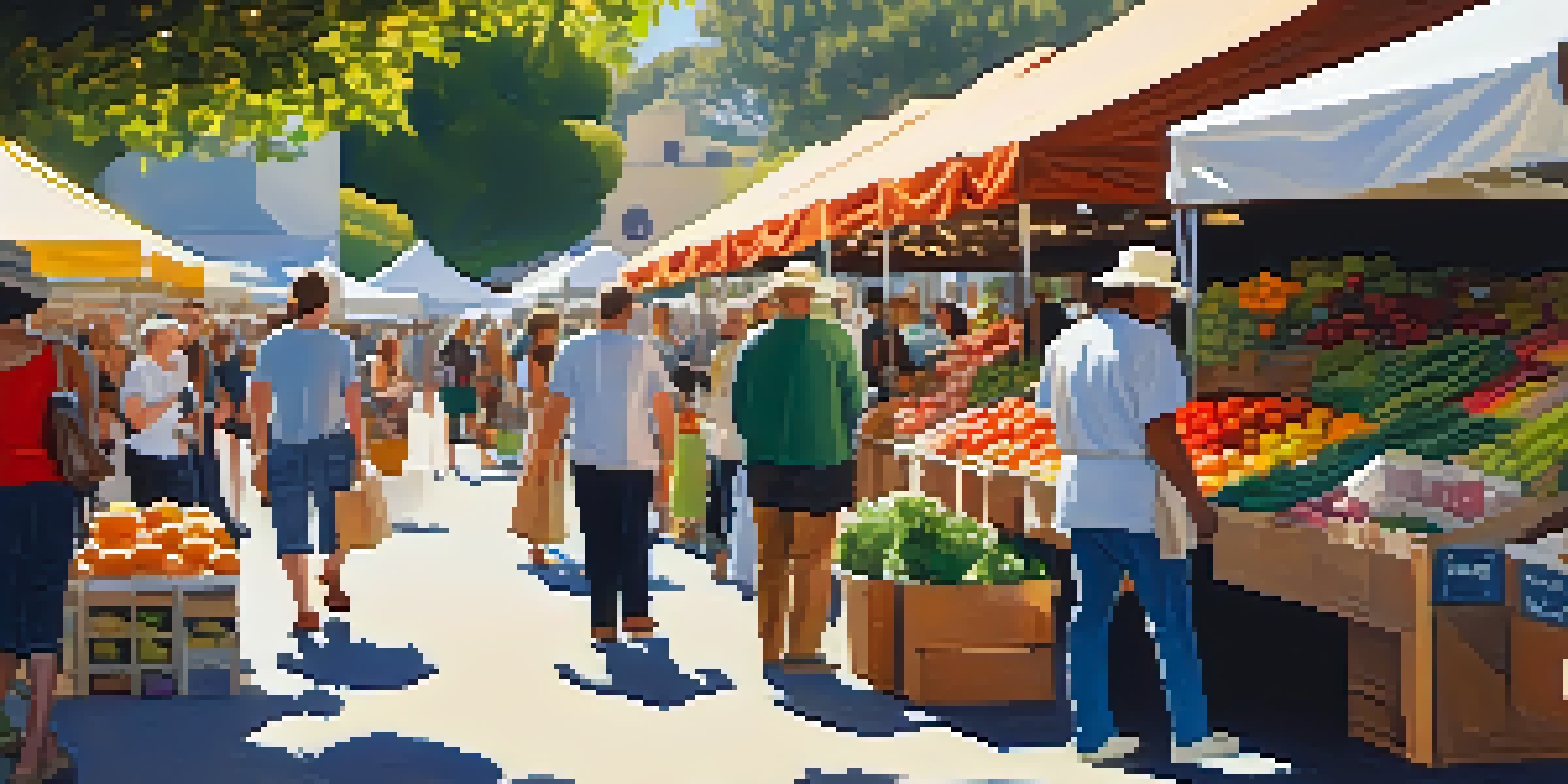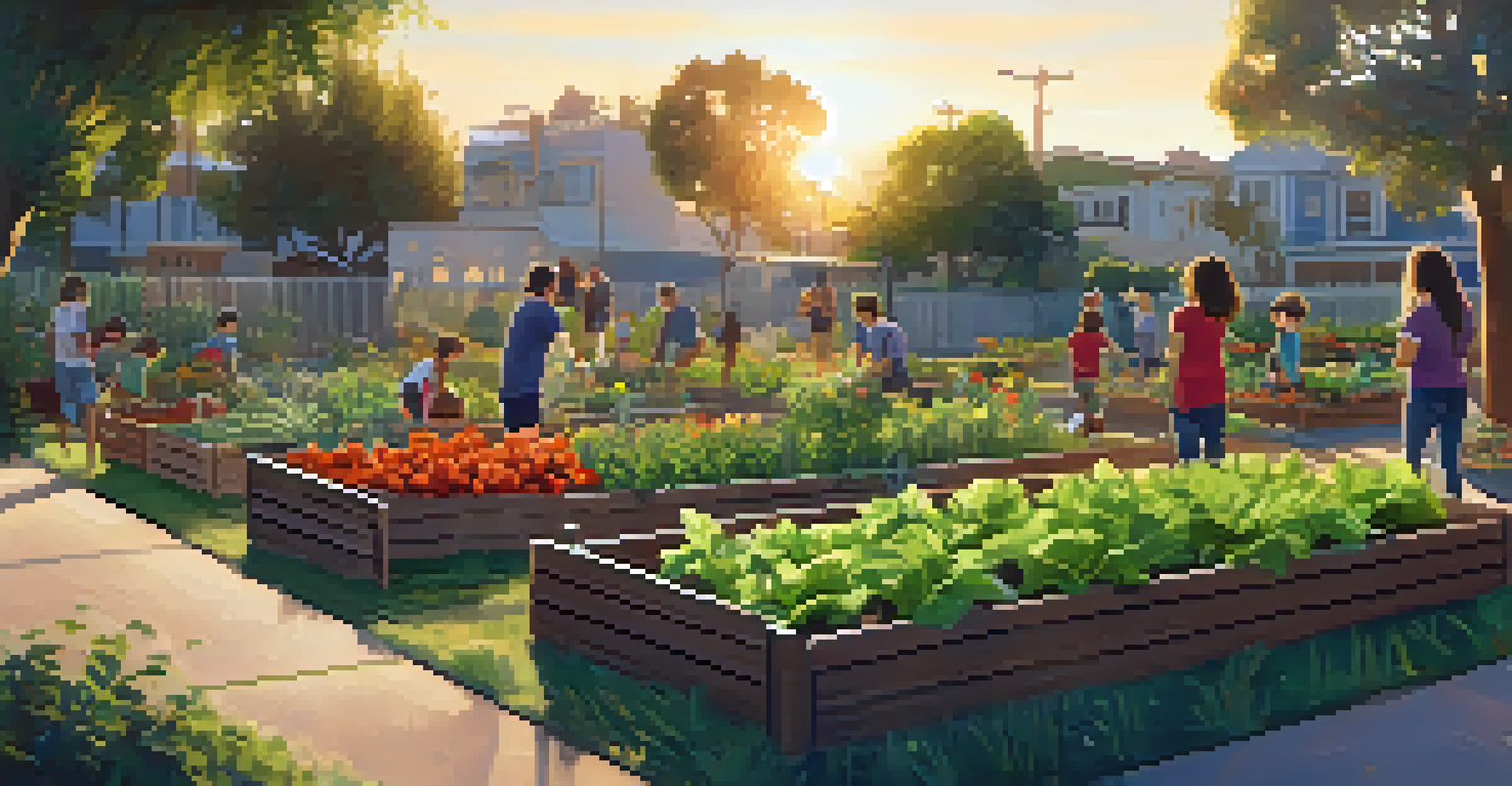Santa Monica's Role in Promoting Local Organic Food Systems

The Roots of Santa Monica's Organic Food Movement
Santa Monica has long been at the forefront of the organic food movement, with its roots stretching back to early community initiatives that promoted sustainable agriculture. The city’s commitment to healthy eating and environmental stewardship has fostered a culture where organic food is not just a trend, but a way of life. This dedication is evident in the numerous farmers' markets and local organic farms that have flourished in the area.
Eating good food is a form of self-respect.
One of the most notable events is the Santa Monica Farmers' Market, which has become a cornerstone for local producers and consumers alike. Established in 1981, it serves as a vibrant hub where residents can purchase fresh, seasonal produce directly from farmers. The market not only supports local agriculture but also educates the community about the benefits of organic eating.
Moreover, Santa Monica’s urban farming initiatives have played a significant role in promoting organic food systems. Community gardens and urban farms are scattered throughout the city, providing residents with hands-on opportunities to grow their own food, learn about sustainable practices, and connect with their neighbors.
Policies Supporting Local Organic Agriculture
Santa Monica’s local government has implemented various policies to bolster its organic food systems. By prioritizing sustainable practices in city planning and zoning, they’ve made it easier for urban farms and community gardens to thrive. This proactive approach demonstrates a clear commitment to promoting health and sustainability within the community.

Additionally, the city has established incentive programs for local farmers, encouraging them to switch to organic practices. By providing financial assistance and resources, Santa Monica is not only supporting existing organic farmers but also inspiring new ones to enter the market. This ensures a continuous supply of fresh, organic produce for residents.
Santa Monica's Organic Food Roots
The city has a rich history of community initiatives that promote sustainable agriculture and healthy eating.
These policies have made a significant impact, as they not only support local economies but also contribute to the reduction of carbon footprints. By fostering a local food system, Santa Monica is leading by example, showing other cities how effective policy can drive positive change.
Education and Awareness Initiatives
Education plays a vital role in Santa Monica's efforts to promote organic food systems. Various programs and workshops are organized throughout the year to teach residents about the benefits of organic farming and healthy eating habits. These initiatives not only empower individuals but also strengthen community ties.
The future of food is not just about what we eat, but how we grow it.
Schools in Santa Monica are also getting involved by incorporating garden-based learning into their curriculums. Students have the opportunity to participate in hands-on gardening projects, learning about where their food comes from and the importance of sustainable practices. This kind of experiential learning fosters a new generation of environmentally conscious individuals.
Moreover, local organizations often collaborate to host events that celebrate organic food and local farmers. These events not only highlight the importance of organic produce but also create a festive atmosphere where community members can come together and share their passion for healthy eating.
The Role of Local Restaurants in Promoting Organic Food
Local restaurants in Santa Monica have embraced the organic movement, making it a focal point of their menus. Many establishments source ingredients from nearby organic farms, ensuring that their dishes are fresh and sustainable. This not only enhances the quality of the food but also supports the local economy.
By highlighting seasonal and locally-sourced ingredients, these restaurants educate diners about the benefits of eating organic. Menus often feature descriptions of where ingredients come from, creating a deeper connection between the food and the community. This transparency fosters a sense of trust and encourages patrons to make healthier choices.
Supportive Policies for Farmers
Local government policies encourage organic farming through incentives, fostering a sustainable local food economy.
Moreover, several restaurants participate in community events that promote organic eating. By engaging with local farmers and suppliers, they help to raise awareness about the importance of supporting sustainable agriculture, further integrating the organic food philosophy into the local culture.
Community Engagement and Volunteer Opportunities
Community engagement is a crucial aspect of Santa Monica’s organic food systems. Residents are encouraged to get involved through various volunteer opportunities at local farms and community gardens. This hands-on involvement not only helps these initiatives thrive but also fosters a sense of community and shared responsibility.
Volunteering in urban farms or community gardens allows individuals to learn about organic farming practices while contributing to food production in their area. It’s a win-win situation—participants gain valuable skills while helping to grow fresh produce that can be shared with neighbors or donated to local food banks.
Events such as garden workdays and farm tours further promote community involvement. These gatherings are not only productive but also fun, turning the act of gardening into a social event where friendships can blossom, all while supporting the local organic food system.
Impact of Technology on Organic Food Systems
Technology is playing an increasingly important role in Santa Monica’s organic food systems. Innovative approaches, such as hydroponics and vertical farming, are being adopted by local farmers to maximize space and yield. These methods not only boost food production but also minimize environmental impact, making organic farming more accessible and efficient.
Mobile apps and online platforms have also emerged, connecting local farmers with consumers directly. This technology allows residents to order fresh produce online, ensuring easy access to organic food without the need for middlemen. Such systems enhance transparency and allow consumers to support local agriculture with just a few clicks.
Community Engagement Drives Growth
Volunteer opportunities and educational initiatives connect residents with organic farming, strengthening community ties.
Furthermore, educational platforms are leveraging technology to reach a broader audience. Online workshops and webinars provide valuable information on organic farming practices, making it easier for individuals to learn and engage, regardless of their location. This digital shift is helping to create a more informed community that values sustainable food systems.
The Future of Organic Food in Santa Monica
Looking ahead, the future of organic food systems in Santa Monica looks promising. With a strong foundation already in place, the city continues to explore new initiatives that can further enhance community engagement and sustainability. The growing interest in organic food among residents indicates a shift towards a healthier lifestyle and a more sustainable food system.
Moreover, as climate concerns become more pressing, local efforts to promote organic agriculture may serve as a model for other cities. Santa Monica can inspire others to adopt similar practices, emphasizing the importance of local food systems in combating environmental challenges.

Ultimately, the commitment of Santa Monica to organic food systems not only benefits its residents but also contributes to a larger movement towards sustainability. As more people recognize the value of organic agriculture, Santa Monica is poised to remain a leader in this vital area.